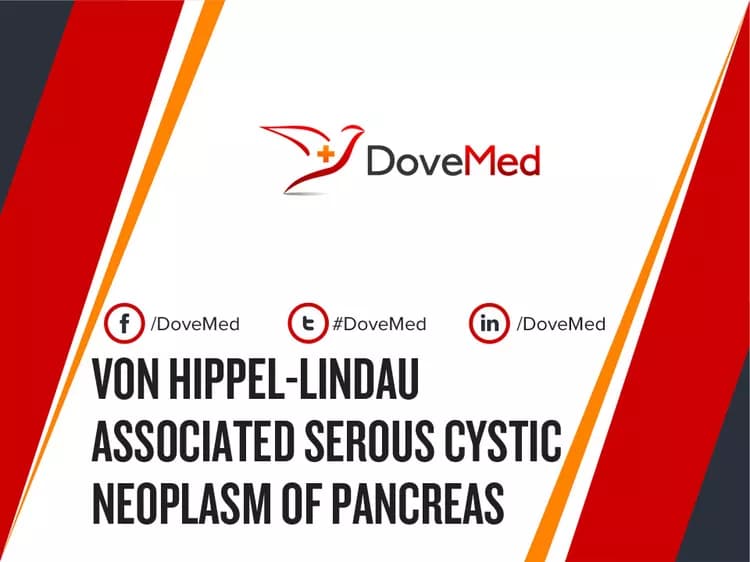
Von Hippel-Lindau Associated Serous Cystic Neoplasm of Pancreas
What are the other Names for this Condition? (Also known as/Synonyms)
- vHL Associated Pancreatic Serous Cystic Neoplasm
- vHL Associated Serous Cystic Neoplasm of Pancreas
- Von Hippel-Lindau Associated Pancreatic Serous Cystic Neoplasm
What is Von Hippel-Lindau Associated Serous Cystic Neoplasm of Pancreas? (Definition/Background Information)
- Von Hippel-Lindau Associated Serous Cystic Neoplasm of Pancreas is a tumor of the pancreas that occurs in the background of von Hippel-Lindau (vHL) syndrome (an inherited genetic disorder). It typically affects young adults
- Usually there are multiple tumors and it can affect any part of the pancreas. Von Hippel-Lindau Associated Serous Cystic Neoplasm of Pancreas can cause abdominal pain, indigestion, and loss of appetite
- Complications that arise from vHL Associated Serous Cystic Neoplasm of Pancreas may include gastrointestinal and biliary tract obstruction (causing jaundice) and injury to local region
- The treatment of the condition would involve treating the underlying von Hippel-Lindau syndrome. However, surgery is an option for tumors that present severe symptoms or complications
- The prognosis of Von Hippel-Lindau Associated Serous Cystic Neoplasm of Pancreas depends upon the severity of vHL syndrome (and the presence of other cancerous tumors due to the syndrome)
The pancreas is an important organ of the digestive system.
- Based on function of the pancreas, it can be functionally divided into 2 parts, namely:
- Exocrine pancreas, which produces digestive enzymes, and
- Endocrine pancreas that produces hormones such as insulin, glucagon, and somatostatin. Insulin and glucagon helps with controlling sugar levels in blood
- 95% of the pancreas is exocrine portion and 5% is endocrine portion. Pancreatic tumors (both benign and malignant) can arise from both the exocrine and the endocrine part
- Based upon anatomy of the pancreas, it can be divided into 3 main parts, namely the:
- Head,
- Body, and
- Tail
- Pancreatic tumors can affect the head, body, and tail region of the pancreas. Some tumors can affect one area of the pancreas more than the other areas.
Hence, localizing the tumor site can guide the healthcare provider to arrive at a probable diagnosis.
Who gets Von Hippel-Lindau Associated Serous Cystic Neoplasm of Pancreas? (Age and Sex Distribution)
- Von Hippel-Lindau Associated Serous Cystic Neoplasm of Pancreas is observed in 90% of the individuals with von Hippel-Lindau syndrome
- vHL syndrome is a congenital genetic disorder that is manifested at birth. However, most tumors develop only by adulthood and the signs and symptoms are observed in young adults
- It can affect both males and females
- The condition can occur worldwide; individuals of all racial and ethnic background may be affected
What are the Risk Factors for Von Hippel-Lindau Associated Serous Cystic Neoplasm of Pancreas? (Predisposing Factors)
- The risk factor for Von Hippel-Lindau Associated Serous Cystic Neoplasm of Pancreas is the presence of vHL syndrome (an autosomal dominant genetic disorder)
- Individuals with a family history of vHL syndrome are also susceptible to this pancreatic tumor
It is important to note that having a risk factor does not mean that one will get the condition. A risk factor increases ones chances of getting a condition compared to an individual without the risk factors. Some risk factors are more important than others.
Also, not having a risk factor does not mean that an individual will not get the condition. It is always important to discuss the effect of risk factors with your healthcare provider.
What are the Causes of Von Hippel-Lindau Associated Serous Cystic Neoplasm of Pancreas? (Etiology)
Von Hippel-Lindau Associated Pancreatic Serous Cystic Neoplasm is caused by vHL syndrome.
- Von Hippel-Lindau syndrome is a genetic disorder inherited in an autosomal dominant pattern
- The condition occurs due to mutations in the VHL gene, which may be inherited or occurs sporadically (new mutations)
What are the Signs and Symptoms of Von Hippel-Lindau Associated Serous Cystic Neoplasm of Pancreas?
The signs and symptoms of Von Hippel-Lindau Associated Serous Cystic Neoplasm of Pancreas depend upon the size and location of the tumor. During the initial stages, small tumors may not cause any signs and symptoms that are readily recognized. Hence, these tumors are only detected incidentally, when being worked-up for other conditions (i.e., diagnostic tests and exams undertaken for other health conditions).
The signs and symptoms may include the following:
- Abdominal pain, back pain
- Loss of appetite
- Weight loss
- Indigestion
- Yellowing of skin (jaundice)
- Nausea and vomiting
- Dark-colored urine
- Fatigue (getting tired easily)
- Signs and symptoms of the underlying vHL syndrome
General features of vHL Associated Serous Cystic Neoplasm of Pancreas includes:
- The tumors are multiple in numbers
- The tumors can be found all over the pancreas - in the head, body, and tail
How is Von Hippel-Lindau Associated Serous Cystic Neoplasm of Pancreas Diagnosed?
The following are the diagnostic methods that may be used to detect vHL Associated Serous Cystic Neoplasm of Pancreas:
- A thorough physical examination and a complete medical history is very important
- Blood test to check for serum amylase levels
- Complete blood count with differential
- Blood tests that may involve tumors markers, such as:
- Carcinoembryonic antigen (CEA)
- CA 19.9
- CA 15.3
- Alpha fetoprotein
- Radiological studies that may include:
- Abdominal ultrasound: A procedure where high-frequency sound waves are used to produce real-time images
- Endoscopic ultrasound: It is a minimally-invasive procedure that uses high-frequency sound waves to obtain detailed images of the pancreas
- CT scan of abdomen: It may be helpful in detecting recurrences, or if metastasis to other organs has occurred
- MRI scan of abdomen: It helps produce high-quality pictures of certain body parts including the tissues, muscles, nerves, and bones
- Additionally, the following magnetic resonance imaging procedures may be used particularly in individuals suspected of having pancreatic tumor/cancer:
- MR cholangio-pancreatography (MRCP)
- MR angiography (MRA)
- Positron emission tomography (PET) scan: It is particularly helpful in visualizing the spread of the cancer to other body parts (metastasis) and/or recurrence
- Percutaneous transhepatic cholangiography (PTC): A contrast material is injected into the bile ducts to visualize the structure
- Endoscopic retrograde cholangio-pancreatography (ERCP): This technique is used when symptoms of pancreatic cancer are present in the individual. A special equipment and dye injections are used to obtain a series of images. If required, a biopsy sample may also be collected during the procedure
- Invasive diagnostic procedures such as:
- Laparoscopy: A special device is inserted through a small hole into the abdomen, to visually examine it. If necessary, a tissue sample is obtained for further analysis. Exploration of the abdomen using a laparoscope is called ‘exploratory laparoscopy’
- Laparotomy: The abdomen is opened through an incision for examination, and if required, a biopsy sample obtained. Exploration of the abdomen using laparotomy procedure is called ‘exploratory laparotomy’
- Molecular analysis for VHL gene mutation
- Tissue biopsy: A tissue biopsy is performed and sent to a laboratory for a pathological examination to the pathologist, who examines the biopsy under a microscope. After putting together clinical findings, special studies on tissues (if needed) and with microscope findings, the pathologist arrives at a definitive diagnosis
The tissue for diagnosis can be procured in multiple different ways, and they include:
- Fine needle aspiration (FNA) biopsy of the pancreatic tumor:
- A FNA biopsy may not be helpful, because one may not be able to visualize the different morphological areas of the tumor. Hence, a FNA biopsy as a diagnostic tool has certain limitations, and an open surgical biopsy is preferred
- A fine needle aspiration of the cyst has limited diagnostic value; however, the aspirated fluid can be analyzed for a variety of proteins such as CEA, CA 19.9, CA 15.3, alpha fetoprotein, and others. Such an evaluation will help in arriving at a diagnosis and classifying the type of cyst
- Core biopsy of the pancreatic tumor
- Open biopsy of the pancreatic tumor
Many clinical conditions may have similar signs and symptoms. Your healthcare provider may perform additional tests to rule out other clinical conditions to arrive at a definitive diagnosis.
What are the possible Complications of Von Hippel-Lindau Associated Serous Cystic Neoplasm of Pancreas?
The complications due to Von Hippel-Lindau Associated Serous Cystic Neoplasm of Pancreas may include the following:
- Gastrointestinal obstruction
- Biliary tract obstruction causing jaundice
- Compress adjoining organs if the tumor size is large, affecting their function
- Injury to local region
- If the cyst destroys enough islet cells of the pancreas, it can result in diabetes
There may be complications from the associated vHL syndrome, due to the presence of other benign and/or malignant tumors, caused by the syndrome.
How is Von Hippel-Lindau Associated Serous Cystic Neoplasm of Pancreas Treated?
The treatment of Von Hippel-Lindau Associated Serous Cystic Neoplasm of Pancreas is linked to the treatment of the underlying von Hippel-Lindau syndrome.
- If there are no signs and symptoms because of the pancreatic tumor(s), then a “wait and watch” approach may be recommended
- If there are worrisome signs and symptoms due to the pancreatic tumor(s), then removal of the tumor or pancreas may be necessary. Under such circumstances, surgical excision of the tumors or a pancreatectomy (partial or total removal of the pancreas) may be performed
- Follow-up care with regular screening and checkups are important
Note: von Hippel-Lindau syndrome can cause other (benign and malignant) tumors to form too. The treatment is based upon the specific circumstance of each individual.
How can Von Hippel-Lindau Associated Serous Cystic Neoplasm of Pancreas be Prevented?
Currently, there are no specific methods or guidelines to prevent Von Hippel-Lindau Associated Serous Cystic Neoplasm of Pancreas. But, if there is a family history of vHL syndrome, then:
- Genetic testing of the expecting parents (and related family members) and prenatal diagnosis (molecular testing of the fetus during pregnancy) may help in understanding the risks better during pregnancy
- If there is a family history of the condition, then genetic counseling will help assess risks, before planning for a child
- Active research is currently being performed to explore the possibilities for treatment and prevention of inherited and acquired genetic disorders such as von Hippel-Lindau syndrome
- Regular medical screening at periodic intervals with tests, scans, and physical examinations are mandatory
What is the Prognosis of Von Hippel-Lindau Associated Serous Cystic Neoplasm of Pancreas? (Outcomes/Resolutions)
- The prognosis of Von Hippel-Lindau Associated Serous Cystic Neoplasm of Pancreas depends upon the severity and management of the underlying von Hippel-Lindau syndrome. The prognosis may not be predictable
- However, regular follow up visits with the healthcare provider are important
Additional and Relevant Useful Information for Von Hippel-Lindau Associated Serous Cystic Neoplasm of Pancreas:
There are different types of serous pancreatic neoplasms. The main types include:
- Serous Cystadenoma of Pancreas
- Macrocystic Serous Cystadenoma of Pancreas
- von Hippel-Lindau Associated Serous Cystic Neoplasm of Pancreas
- Solid Serous Cystadenoma of Pancreas
- Mixed Serous Neuroendocrine Neoplasm of Pancreas
It is estimated that the average lifetime risk of developing pancreatic cancer is about 1.5%.
Related Articles
Test Your Knowledge
Asked by users
Related Centers
Related Specialties
Related Physicians
Related Procedures
Related Resources
Join DoveHubs
and connect with fellow professionals

0 Comments
Please log in to post a comment.